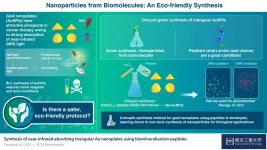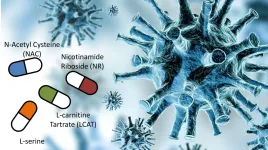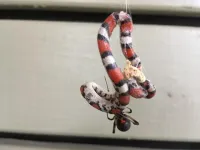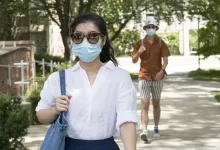Striking gold: Synthesizing green gold nanoparticles for cancer therapy with biomolecules
2021-06-28
(Press-News.org) In cancer therapy, the effectiveness of an approach is determined by its ability to preserve the non-cancerous cells. Simply put, the higher the collateral damage, the greater are the side-effects of a therapy. An ideal situation is where only the cancer cells can be targeted and destroyed. In this regard, photothermal therapy--an approach in which cancer cells infused with gold nanoparticles can be heated up and destroyed using near-infrared (NIR) light that is strongly absorbed by the gold nanoparticles--has emerged as a promising strategy due to its minimally invasive nature.
"Because NIR light is able to penetrate biological tissues, it can illuminate the gold nanoparticles within the body and turn them into nano-sized cell heating agents," explains Prof. Masayoshi Tanaka from Tokyo Institute of Technology (Tokyo Tech), Japan, who researches nanomaterials for biomedical applications.
In particular, gold nanoplates (AuNPls) are extremely attractive as photothermal therapeutic agents owing to their efficient absorption of NIR light. However, synthesizing these nanoparticles requires harsh reagents and highly toxic conditions, making the process hazardous. In a new study, Prof. Tanaka and his collaborators from UK (University of Leeds) and Korea (Chung-Ang University) have now addressed this issue by developing a safer and more eco-friendly protocol for AuNPl synthesis, the results of which are published in ACTA Biomaterialia.
The team took the hint from a process called "biomineralization" that uses biomolecules to generate metal nanoparticles with tunable structures. "Peptides, or short chains of amino acids, are particularly attractive candidates for this purpose because of their relatively small size and stability. However, their use for producing Au nanoparticles with optimized structures for efficient NIR absorption has not yet been reported," says Prof. Tanaka.
Motivated, the team began by identifying peptides suitable for the mineralization of AuNPls and, after picking out over 100 peptides, decided to examine the potential of a peptide named B3 for synthesizing AuNPls with controllable structure that can serve as photothermal conversion agents.
In a process called "one pot synthesis", the team mixed a gold salt, HAuCl4, along with B3 peptide and its derivatives at various concentrations in a buffer solution (an aqueous solution resistant to changes in pH) at neutral pH and synthesized triangular and circular-shaped AuNPls with different levels of NIR absorption based on the peptide concentration.
The team then tested the effect of the AuNPls on cultured cancer cells under irradiated conditions and found them to exhibit the desired therapeutic effects. Furthermore, on characterizing the peptide using B3 derivatives, they found that an amino acid called histidine governed the structure of the AuNPls.
"These findings provide not only an easy and green synthetic method for AuNPls but also insight into the regulation of peptide-based nanoparticle synthesis," comments Prof. Tanaka excitedly. "This could open doors to new techniques for non-toxic synthesis of nanoparticle therapeutic agents."
Indeed, we might have struck gold with gold nanoparticles!
INFORMATION:
[Attachments] See images for this press release:

ELSE PRESS RELEASES FROM THIS DATE:
2021-06-28
The Structural Bioinformatics and Network Biology laboratory, led by ICREA Researcher Dr. Patrick Aloy, has completed the bioactivity information for a million molecules using deep machine-learning computational models. It has also disclosed a tool to predict the biological activity of any molecule, even when no experimental data are available.
This new methodology is based on the Chemical Checker, the largest database of bioactivity profiles for pseudo pharmaceuticals to date, developed by the same laboratory and published in 2020. The Chemical Checker collects information from 25 spaces of bioactivity for each molecule. These spaces are linked to the chemical structure of the molecule, the targets with which it interacts or the changes ...
2021-06-28
For the first time, scientists from the German Cancer Consortium (DKTK) partner site in Essen/Düsseldorf have discovered stem cells of the hematopoietic system in glioblastomas, the most aggressive form of brain tumor. These hematopoietic stem cells promote division of the cancer cells and at the same time suppress the immune response against the tumor. This surprising discovery might open up new possibilities for developing more effective immunotherapies against these malignant brain tumors.
The DKTK is a consortium centered around the German Cancer Research Center (DKFZ) in Heidelberg, which has long-term collaborative partnerships with specialist oncological centers at universities across Germany.
Glioblastomas ...
2021-06-28
Metabolic activators were found to reduce recovery time by as many as 3.5 days in patients with mild-to-moderate Covid-19, according to a Swedish-British study published today in Advanced Science.
The researchers also found that treatment with the metabolic activators improved liver health and decreased the levels of inflammation, as shown by inflammatory markers.
Conducted by researchers at Science for Life Laboratory at KTH Royal Institute of Technology in Stockholm, in collaboration with the Sahlgrenska Academy in Gothenburg and King's College, London, the ...
2021-06-28
Want to have a happy relationship? Make sure both partners feel they can decide on issues that are important to them. Objective power measured by income, for example, doesn't seem to play a big role, according to a new study in the "Journal of Social and Personal relationships" by the Martin Luther University Halle-Wittenberg (MLU) and the University of Bamberg. Instead, how lovers perceive power dynamics in their relationship is most important for relationship satisfaction.
Power is about being able to influence people and successfully resist the attempts of others to influence you. "It sounds like a dog-eat-dog world or the world of business. ...
2021-06-28
The examined tissue does not need to be marked for this. The analysis only takes around half an hour. "This is a major step that shows that infrared imaging can be a promising methodology in future diagnostic testing and treatment prediction," says Professor Klaus Gerwert, director of PRODI. The study is published in the American Journal of Pathology on 1 July 2021.
Treatment decision by means of a genetic mutation analysis
Lung tumours are divided into various types, such as small cell lung cancer, adenocarcinoma and squamous cell carcinoma. Many rare tumour types and sub-types also exist. This diversity hampers reliable rapid diagnostic methods in everyday clinical ...
2021-06-28
There are spiders that eat snakes. Observations of snake-eating spiders have been reported around the world. Two researchers from Basel and the US consolidated and analyzed over 300 reports of this unusual predation strategy.
Spiders are primarily insectivores, but they occasionally expand their menu by catching and eating small snakes. Dr. Martin Nyffeler, arachnologist at the University of Basel, and American herpetologist Professor Whitfield Gibbons of the University of Georgia, USA, got to the bottom of this phenomenon in a meta-analysis. Their findings from ...
2021-06-28
Announcing a new article publication for BIO Integration journal. In this article the authors Chunxiong Zheng, Mingqiang Li and Jianxun Ding from Sun Yat-sen University, Guangzhou, China and Changchun Institute of Applied Chemistry, Changchun, China discuss the challenges and opportunities of nanomedicines in clinical translation.
Researchers are rapidly gaining a much deeper understanding of the challenges and opportunities of nanomedicines allowing for improvements in disease treatment and improved patient survival.
Deep exploration of the connections between preclinical and clinical ...
2021-06-28
In March 2020, daily life in the United States changed in an instant as the country locked down to deal with the initial wave of the COVID-19 pandemic. New research reveals how residents in one community returned to their routines as the restrictions lifted, according to a team of Penn State scientists.
"We used sound signals captured by underground fiber-optic sensors to understand how COVID measures impacted human activities," said Junzhu Shen, a graduate student in geosciences at Penn State. "These sensors provide very accurate, high-resolution data that can help us understand what's happening in our communities."
The scientists analyzed sound data recorded from March through June 2020 in and around the Penn State University Park campus and State College, ...
2021-06-28
Researchers have developed smart wound dressings with built-in nanosensors that glow to alert patients when a wound is not healing properly.
The multifunctional, antimicrobial dressings feature fluorescent sensors that glow brightly under UV light if infection starts to set in and can be used to monitor healing progress.
The smart dressings, developed by a team of scientists and engineers at RMIT University in Melbourne, Australia, harness the powerful antibacterial and antifungal properties of magnesium hydroxide.
They are cheaper to produce than silver-based dressings but equally as effective in fighting bacteria and fungi, with their antimicrobial power lasting up to a week.
Project leader Dr Vi Khanh Truong said the development of cost-effective antimicrobial ...
2021-06-28
Results of this technique, known as transfer learning, achieved a 99.24 per cent success rate when detecting COVID-19 in chest x-rays.
The study tackles one of the biggest challenges in image recognition machine learning: algorithms needing huge quantities of data, in this case images, to be able to recognise certain attributes accurately.
ECU School of Science researcher END ...
LAST 30 PRESS RELEASES:
[Press-News.org] Striking gold: Synthesizing green gold nanoparticles for cancer therapy with biomolecules




